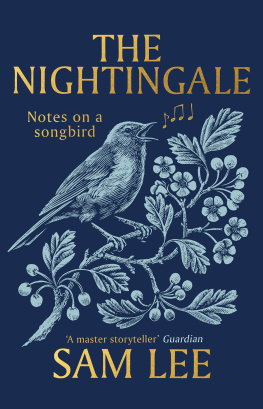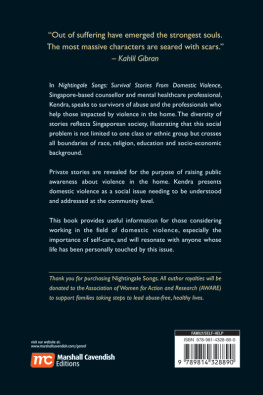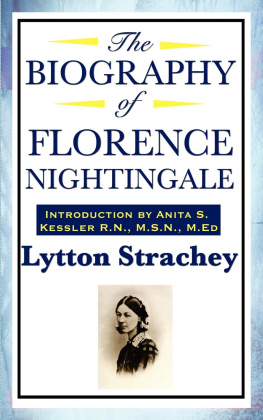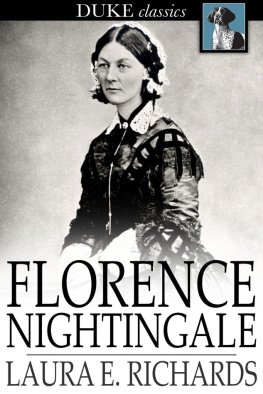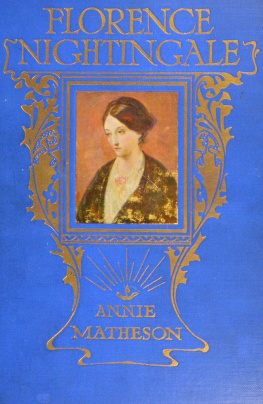
Sam Lee
THE NIGHTINGALE

CONTENTS
ABOUT THE AUTHOR
Sam Lee is a Mercury Prize-nominated and BBC Folk Award-winning singer, conservationist and curator. Trained in fine art but with a lifelong passion for wilderness studies and nature connection, Sam is a folk music specialist dedicated to collecting, sharing and interpreting ancient oral music from Britain and Ireland. He has combined these interests through his Singing with Nightingales annual springtime concert series.
His singing has been heard in films and TV shows, from Guy Ritchies King Arthur: Legend of the Sword to Peaky Blinders. Sam was musical director for the RSPBs 2019 Top 20 birdsong single, Let Nature Sing and his 2020 album Old Wow garnered five-star reviews. He has lectured at Goldsmiths, SOAS and Oxford University and was the first folk singer to teach at the Royal College of Music.
Dedicated to Oran Summer Cecilia Lee and to all those who stop to listen.
LIST OF IMAGES
In order of appearance
J. A. Naumanns Naturgeschichte der Vgel, Naumann, Johann Andreas The British Library Board
Robin. Familiar Wild Birds by W Swaysland (Cassell, c 1900) c Look and Learn/Bridgeman Images/Redstart. Familiar Wild Birds by W Swaysland (Cassell, c 1900) c Look and Learn/Bridgeman Images/Svenska Faglar efter Naturen och pa sten ritade. By Magnus, Wilhelm and Ferdinand von Wright c Purix Verlag Volker Christen/Bridgeman Images
The Nightingales migration route Darren Bennett/DKB Creative
Rostock Pfeilstorch, Zoologische Sammlung der Universitt Rostock | Wikipedia
Nightingale distribution in the UK Darren Bennett/DKB Creative
Thrush nightingale, Luscinia luscinia Mary Evans Picture Library
NIGHTINGALE SINGING Mary Evans Picture Library
Just a Song at Sunset (Luscinia megarhyncus) Mary Evans Picture Library
Nightingale Song, Topical Press Agency/Stringer Getty Images
For The Birds, Topical Press Agency/Stringer Getty Images
Nightingale Look and Learn/Bridgeman Images
North east view of Selbourne British Library Board. All Rights Reserved/Bridgeman Images
Eugenio Bettoni, Storia naturale degli uccelli che nidificano in Lombardia DE AGOSTINI PICTURE LIBRARY/Contributor | Getty Images
Antique illustration of nightingales (Luscinia megarhynchos) and nest stock illustration, illbusca | Getty Images
Jack-in-the-Green, a May-Day Scene Sixty Years ago (engraving), Look and Learn/Illustrated Papers Collection/Bridgeman Images
Nightingale, nest and egg, Luscinia megarhynchos Mary Evans Picture Library
Nightingale Look and Learn/Bridgeman Images
Luscinia megarhynchos, common nightingale Mary Evans Picture Library
1 kuna coin, 1993, obverse, nightingale, Croatia, 20th century A. Dagli Orti/De Agostini Picture Library/Bridgeman Images
Nightingale, benoitb Getty Images
The Nightingale of France, c.1830 (colour litho) Archives Charmet/Bridgeman Images
Philomele and Progne Philomel And Progne Bridgeman Images
Nightingale, Luscinia megarhynchos Mary Evans Picture Library
Nightingale Illustration Andrew_Howe Getty Images
Nightingales singing at night, clu Getty Images
The Emperor and the Nightingale, illustration for The Nightingale from Fairy Tales by Hans Christian Andersen Archives Charmet/Bridgeman Images
The Hawk and the Nightingale, from A Hundred Fables of Aesop, 1903 (engraving) The Stapleton Collection/Bridgeman Images
Philomel and Progne from Fontaine Fables, pub. 1905 (engraving) The Stapleton Collection/Bridgeman Images
Roses and Nightingale, late 18th century (ink & colour on paper) Gift of Nasrin and Abolala Soudavar/Bridgeman Images
Samuel Taylor Coleridge, Culture Club/Contributor Getty Images/John Keats, English poet, and his Ode to a Nightingale, 1819 (1958), Print Collector/Contributor Getty Images/John Clare, Edward Gooch Collection/Stringer Getty
Nightingale and the Bomber, ATM
Nightingales Nest (engraving) Look and Learn/Bridgeman Images
Nightingale on its nest Mary Evans Picture Library
Natural History, Nightingale (Luscinia megarhynchos), duncan1890 Getty Images
Nightingale and Oak, Angela Harding
The Bear and Nightingales Jackie Morris
INTRODUCTION
It was twelve long months since first we met
So early in the spring
When the small birds they did whistle and
The nightingales they sang.
The Tan Yard Side, traditional English folk song, as sung by Phoebe Smith
According to folk song, birds merely whistle, but the nightingale sings. How can it be that this little brown bird, in so many ways indistinct from his fellow scrub-and sky-dwelling companions, has risen to a status vocally so far above the accolades for any other bird?
Before we embark on the wondrous journey concerning how this bird has sung his way into so many worlds, lives, languages and laments, I should add the caveat that the nightingale is, in every respect, rivalled by many other technically gifted and virtuosic species. The crooning wailings of the curlew, the incandescence of the blackbird, the declarative whoops and hollering of the song thrush or the travelogue retellings of the marsh warbler singing back the fragments of other birds heard on its migration these songs all warrant the same level of human adoration and reverence, but somehow nightingales got the fat worm, when it came to notoriety and cultural elevation. This comes down to timing not just the spacious, rhythmic patter and patterns in their song, but their chosen time: the night-time. When most other creatures rescind their notes, leaving the land a darkened theatre between performances, in comes the nightingale, putting on a springtime show.
Every bird tells a story, and each of these stories tells something of that feathered kind and of their weavings within the tapestry of our human world. Like a prism splitting light-beams, the nightingale and his song refract localised notions of place, home, matters of the heart and rootedness. Though weighing in at only a few grams, the migratory nightingale carries enormous symbolic and sentimental gravitas in all of its summering homes, and appears on the tongues of people in varied levels of localised esteem, through legends, tales and songs, each one imbuing our bird with greater depth and nuance. In sub-Saharan Africa, where the nightingale winters, there seem to be few cultural references to the bird, perhaps because it does very little singing at this point in its life; but nightingales reverberate across Europe, the Caucasus, the Near and Middle East and all the way over to the Indian subcontinent, in some of the oldest music known to humankind. Nightingales are master infiltrators, finding their way into secular folk song and sacred devotional music alike.
I came to meet the nightingale through folk song, the ancient, anonymously scribed repertoire native to the British Isles that often traces itself outwards to lands far away. Folk songs describe the various interplays between humans and the landscape. They nod to the ways in which we encountered the land, its flora and fauna including, of course, birds. I have always been a child of nature, spending my youth and early adulthood studying the arts of nature connection and wilderness bushcraft skills with masters such as Ray Mears and Jon Young. In my early adulthood the discovery of folk song was like finding a lost hieroglyphic, a language of connectedness and enchantment sparking an exciting, deep love and hunger for these songs to be learned and sung.
Next page
